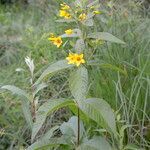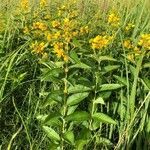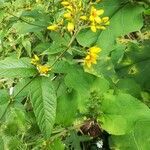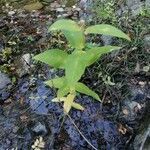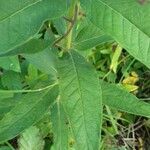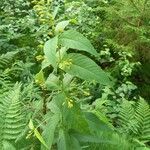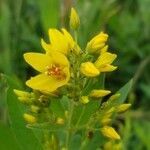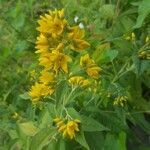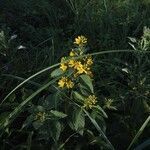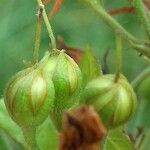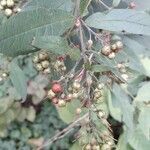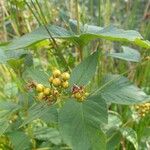Summergreen herb; stems erect, ± minutely glandular-hairy, to c. 1 m tall, arising from underground rhizomes. Lvs opposite, shortly petiolate to subsessile. Lamina 4-11 × 1.5-4 cm, lanceolate to ovate or elliptic, glabrous above, minutely glandular-hairy beneath and dotted with black glands, entire; base cuneate to rounded; apex acute. Panicle terminal, many-flowered, glandular-puberulent, with leaflike bracts subtending lower branches; upper bracts subulate to lanceolate. Pedicels often > fls. Calyx 4-5 mm long; lobes lanceolate, acuminate, rounded at base, glandular-ciliate and dark-margined. Corolla limb c. 2 cm diam., yellow, often with pinkish flush towards base, dotted with minute glands; lobes 7-10 mm long, ± elliptic-oblong. Stamens 3-5 mm long; filaments united to c. ⅓ length, densely glandular-scaly. Style > stamens, glabrous. Capsule 3-4.5 mm diam., ± globose. Seed broad-ellipsoid, flattened with thick rounded margin.
Stems erect, to 1 m, from long, stoloniform rhizomes, ± soft-hairy; lvs whorled or opposite, punctate, lanceolate to lance-ovate, 7–12 cm, soft-hairy beneath; infl a terminal raceme and a series of peduncled short racemes or panicles from the upper axils; cal-lobes 2.5–4.5 mm, red-margined; cor-lobes 8–12 mm, entire; 2n=56, 84. Native of Eurasia, occasionally escaped from cult. in our range.
Stems erect, to 1 m, from long, stoloniform rhizomes, ± soft-hairy; lvs whorled or opposite, punctate, lanceolate to lance-ovate, 7–12 cm, soft-hairy beneath; infl a terminal raceme and a series of peduncled short racemes or panicles from the upper axils; cal-lobes 2.5–4.5 mm, red-margined; cor-lobes 8–12 mm, entire; 2n=56, 84. Native of Eurasia, occasionally escaped from cult. in our range.
A herb. It keeps growing from year to year. It grows 100 cm high. The branches are softly hairy. The lower leaves are alternate and the higher leaves are in rings. The leaf blade is 5-6 cm long by 3-4 cm wide. They are narrowly oval and darker on the upper surface.
